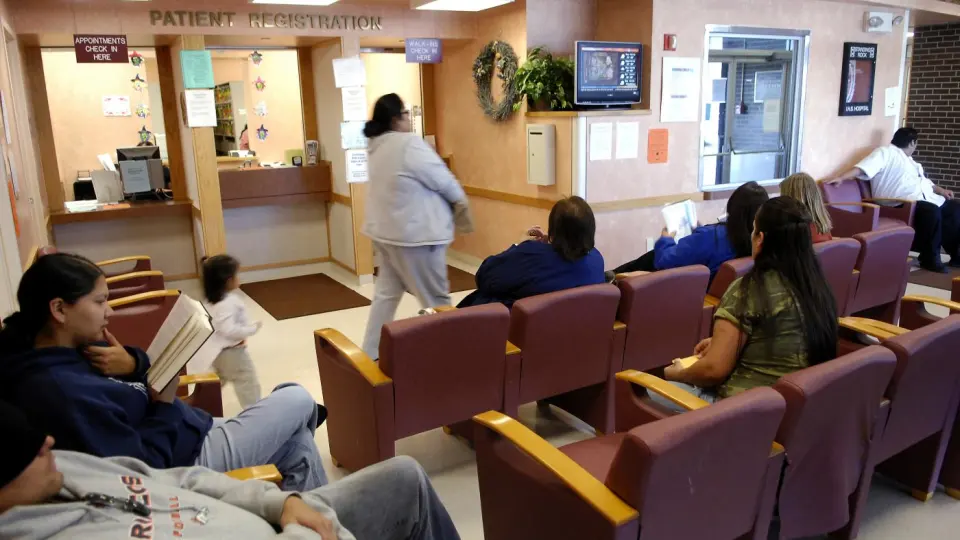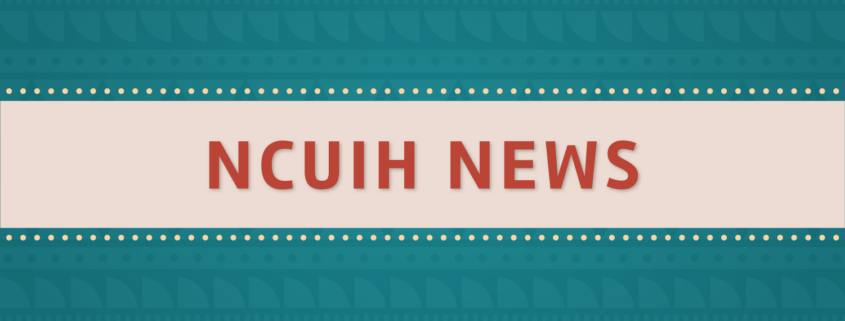MEDIA MENTION: White House wants Native American health care funding baked into law

In this photo taken Oct. 14, 2008, people sit in the Indian Health Services waiting room on Standing Rock Reservation in Fort Yates. N.D. (AP Photo/Will Kincaid)
On the Standing Rock Indian Reservation, which straddles the border between North and South Dakota, people line up at 6 a.m. in the freezing winter, hoping to get one of just four dental appointments.
“If you don’t get those four, you’re out, you don’t get it,” said Janet Alkire, chairwoman of the Standing Rock Sioux Tribe, who described the scene at an April hearing of the House Natural Resources Subcommittee on Indian and Insular Affairs.
And the lack of adequate medical care extends well beyond dental care, she told lawmakers.
“Our babies cannot be born on our reservation,” she said. “Mothers have to leave their support networks, their families, sometimes the dads, definitely the grandmothers, behind and travel over 75 miles to deliver a baby.”
Through the Indian Health Service, the federal government provides free medical care for Native Americans, which the United States promised in various treaties with indigenous nations when it forced them from their lands in the mid-19th century.
However, many Native Americans complain that the U.S. government breaks this promise by underfunding the Indian Health Service.
In order to solve this problem, the Biden administration wants to take Indian Health Service funding out of the annual budget negotiation process and instead have it baked into law. Its plan would culminate in around $44 billion in funding in fiscal 2033 — six times greater than current funding levels, but still short of what experts and advocates say is needed.
Indian Health Service funding has increased 68 percent in the past decade, culminating in $7.1 billion for the agency for fiscal 2023. But the agency’s funding is significantly less than other federal health care programs. In 2017, Indian Health Service spending per capita was less than half of that of the Veterans Health Administration and less than a third compared to Medicare, according to a report by the Government Accountability Office.
The National Tribal Budget Formulation Workgroup, a group of Native American advocates and tribal representatives that advises the Indian Health Service on its annual budget request, estimates that nearly seven times more funding for the agency is needed to meet Native health care needs.
In her testimony, Alkire described the impact of this lack of adequate funding.
“The IHS hospital at Standing Rock is more than 60 years old,” she said. “It is falling apart and lacks space for life-saving equipment.”
“We recently purchased a CT scan (machine) with our own limited funds,” Alkire added. “There was no room, and we had to build it in the back entry to the building. But we do what we have to do, right?”
Such problems are not limited to that specific hospital. According to the Workgroup’s report on its fiscal 2024 budget recommendations, Indian Health Service hospitals have only 52 percent of the space needed based on the size of the population the agency cares for. Hospitals in Indian Country are also nearly four times older than the national average, the report says.
In its fiscal 2024 budget proposal, released in March, the Biden administration called for full mandatory funding for the Indian Health Service by fiscal 2025. The agency currently receives most of its funding through discretionary spending, which must be debated by Congress each year through the appropriations process. Programs like Medicare and Medicaid receive mandatory funding, meaning they’re automatically given a certain amount each year as determined by law.
The White House is asking for $9.7 billion in total Indian Health Service funding for fiscal 2024, including $1.6 billion in proposed mandatory funding for certain expenses. By fiscal 2025, the administration wants all Indian Health Service funding to be mandatory, with automatic spending increases to address increasing costs, existing backlogs and key operational needs.
In its congressional budget justification, the Indian Health Service says mandatory funding is necessary to get the full amount of funding it needs, as otherwise it’s limited by discretionary budget caps. The debt ceiling deal signed by Biden last week keeps nondefense discretionary spending flat next year and only allows for a 1 percent increase in fiscal 2025.
White House press secretary Karine Jean-Pierre said this change is part of the Biden administration’s goal to lift up groups that have been historically underserved.
“There are communities, whether it’s Indian Country, Native Americans, whether it’s rural America, whether it’s urban America, where people have felt left behind,” she said in April. “This is a story that is part of (Biden’s) economic policy, which is not leaving anybody behind, making sure that people get the assistance, they get the help that they sorely need.”
Native American advocates have been pushing for mandatory Indian Health Service funding for years. One such group, the National Council of Urban Indian Health, advocates for the health care needs of Native Americans living in urban areas. The council’s vice president of policy and communications, Meredith Raimondi, said unpredictable funding creates barriers to providing health care.
“If you’re a health care clinic and you’re trying to hire staff, and you don’t know what your funding is going to be next year, it’s a lot harder to plan and retain staff. It’s harder to buy lab equipment. It’s harder to know if you can pay (for) your lab testing and your vendors,” Raimondi said. “So it makes it extremely hard to deliver health care at a time when our health care needs are at an all time high.”
Making Indian Health Service funding mandatory would require an amendment to the Indian Health Care Improvement Act, which authorizes funding for the agency.
Congress appears divided on the issue.
In an interview, Sen. Brian Schatz (D-Hawaii), who chairs the Senate Committee on Indian Affairs, said he supports making Indian Health Service funding mandatory. But Rep. Harriet Hageman (R-Wyo.), chair of the House Natural Resources Subcommittee on Indian and Insular Affairs, criticized the idea at a May hearing, suggesting the agency’s problems are actually the result of poor management.
“We need to see significant progress before how IHS is funded can significantly change,” Hageman said.
She said it’s important to focus on cutting the federal deficit.
“I just did a poll this week as to some of the issues that are the most important to my constituents in the state of Wyoming, and the budget and government and federal spending is at the top of the list,” Hageman said.
However, Ranking Member Rep. Teresa Leger Fernández (D-N.M.) pointed out that Biden’s proposed budget would actually reduce the deficit. Biden has proposed cutting the deficit by nearly $3 trillion over the next 10 years, largely by raising taxes on the wealthiest Americans.
“There are ways to reduce the deficit while also investing in what is important,” Leger Fernández said.
Raimondi said Native health care shouldn’t be cut to lower the deficit.
“Native Americans who gave up their land and who entered into treaties and have a trust relationship with the federal government are owed health care, regardless of whether or not the federal government needs to fix its deficit or cut costs,” Raimondi said.
Biden also requested full mandatory funding for the Indian Health Service last year, the first time that a president did so, according to that year’s Indian Health Service congressional budget justification. While this ultimately did not come to fruition, the last budget did make a significant change by providing advance appropriations for the agency, meaning some funding for fiscal 2024 was provided a year in advance. Prior to this change, the Indian Health Service was the only major federal health care provider to be funded solely by regular yearly appropriations.
This change means the agency will have more protection from government shutdowns. The 2018-2019 shutdown, which lasted 35 days, caused major disruptions to the agency’s services. At least five Indian Health Service patients died during the shutdown, according to the National Council of Urban Indian Health.
Raimondi said advance appropriations are an important step, but they still have to be passed by Congress each year. She said mandatory funding is needed to ensure proper health care for Native Americans.
“You need to have the mandatory funding so it’s not subject to the whim of political fights,” Raimondi said. “And so that we know that American Indian and Alaska Native people will have access to the health care that they deserve and earned.”





Leave a Reply
Want to join the discussion?Feel free to contribute!